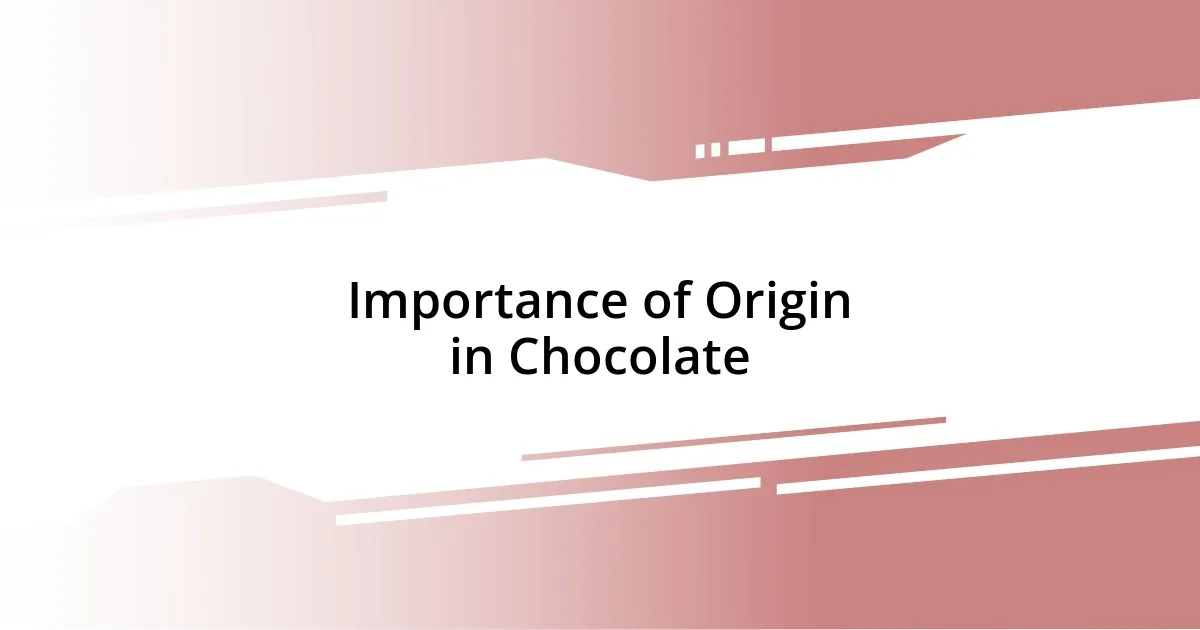Key takeaways:
- Understanding chocolate flavor profiles is influenced by factors such as origin, bean type, and roasting process, creating a rich connection between taste and place.
- The origin of chocolate significantly impacts its flavor, with aspects like terroir, bean variety, cultural practices, and harvest timing shaping the overall experience.
- Pairing chocolate with various flavors, such as fruits and spices, can elevate the tasting experience, revealing new dimensions and enhancing enjoyment.
- Recording and analyzing tasting experiences in a journal helps individuals develop personal preferences and deepen appreciation for the complexities of chocolate.

Understanding Chocolate Flavor Profiles
Understanding chocolate flavor profiles is like embarking on a delightful journey through a world of sensory experiences. I remember the first time I tasted a single-origin dark chocolate—it was an eye-opener. The rich, earthy notes danced on my palate, not merely a treat but an awakening. Can you feel that connection between taste and place, just as we do with wine?
Not all chocolates are created equal; their flavors can change dramatically based on origin, bean type, and even the roasting process. I’ve often found myself lost in a chocolate tasting, where the nuanced flavors shift from fruity to nutty, sometimes even bringing a hint of spice, and it amazes me every time. Isn’t it fascinating how a single bite can evoke memories or feelings, transporting us to different landscapes and cultures?
To truly appreciate chocolate, one must pay attention to these subtleties. I’ve learned that savoring chocolate mindfully, allowing it to melt and unfold its layers of flavor, opens up a whole new world of experience. Have you ever closed your eyes while tasting chocolate? It’s a simple act that can amplify every nuance and texture, making each encounter with chocolate truly special.

Importance of Origin in Chocolate
The origin of chocolate plays a crucial role in shaping its flavor profile, much like how the terroir influences wine. For example, during a visit to a cacao plantation in Ecuador, I was astonished by how the rich volcanic soil imparted a complexity to the beans that I had never encountered before. Each region produces distinct notes—Minnesota’s chocolate may boast berry undertones, while Bolivian varieties lean toward floral flavors. Isn’t it intriguing how the land can tell a story through taste?
Here are some key factors highlighting the importance of origin in chocolate:
- Terroir: The environmental conditions, including soil type and climate, affect the cacao’s flavor.
- Bean Variety: Different cacao species (e.g., Criollo, Forastero, Trinitario) each have unique characteristics and flavor profiles.
- Cultural Practices: Traditional farming methods and fermentation techniques vary across regions, influencing flavor development.
- Harvest Timing: The timing of the cacao harvest can significantly impact the chocolate’s taste; beans picked at their peak often yield the best flavors.
Reflecting on these aspects really deepens my appreciation for each chocolate bar I encounter. Every square or truffle whisk me back to those vibrant landscapes, reminding me of the passionate artisans and farmers behind the craft. It gives chocolate a richer context—each piece not just a confection, but an experience steeped in culture and history.

Identifying Flavor Notes in Chocolate
Identifying flavor notes in chocolate is like tuning into a beautiful symphony. Each tasting experience reveals complex layers that come together in harmony. I recall a magical moment during a tasting session when I encountered chocolate with hints of raspberry and warm spices. It sparked a memory of my grandmother’s spiced berry pie—how incredible that a bite of chocolate could transport me back in time!
As I explore different chocolate bars, I’ve learned that specific flavor notes arise from various factors. The cacao’s fermentation process, for instance, influences how the natural notes bloom. When tasting a chocolate with citrus undertones, I often think of the bright oranges from my childhood garden. This connection makes each tasting not just an analysis but a profound journey through my memories.
To hone my palate, I keep a flavor wheel handy, a tool that guides me in recognizing and classifying the intricate notes. I find it incredibly rewarding to articulate the flavors I detect. Are they nutty, fruity, or perhaps floral? This practice has enhanced my appreciation for chocolate, transforming my taste buds into explorers of taste. I often invite friends to join me, turning chocolate tasting into an interactive experience, where we can share our findings and enjoy the delightful surprises together.
| Flavor Notes | Description |
|---|---|
| Fruity | Notes reminiscent of berries, citrus, or tropical fruits. |
| Nutty | Hints of walnuts, almonds, or hazelnuts, adding warmth. |
| Spicy | Subtle notes of cinnamon, nutmeg, or even pepper. |
| Floral | Delicate fragrances resembling jasmine, rose, or lavender. |
| Earthy | Rich, grounding notes evoking forest soil or toasted wood. |

Tasting Techniques for Chocolate
Tasting chocolate is an art that requires intentionality and practice. One technique I have found particularly enlightening is the “snap test.” When you break a piece of chocolate, the sharp sound it makes indicates freshness and quality. I remember the first time I learned this; the satisfying crack echoed in the quiet room, raising my excitement for the tasting that was about to unfold. It’s such a simple action, but it can really set the stage for the experience.
As I dive into tasting, I pay careful attention to the chocolate’s texture. The way it melts in my mouth offers clues about its composition. For instance, creamy chocolate coats my palate beautifully, lingering pleasantly. In contrast, a rougher texture may hint at a more rustic production method that aligns with authentic flavors. Have you ever thought about how texture can influence flavor perception? It’s fascinating! When you combine smoothness with rich cocoa notes, the result is truly delightful.
I also practice the “four-step tasting method,” which includes looking, smelling, tasting, and savoring. I vividly recall a tasting where I methodically recorded my thoughts after each step, allowing the chocolate to reveal its nuances as I took my time. I found that the aroma transported me to a distant cocoa farm, where I could almost feel the sun on my skin. It’s these layers of experience that make a simple piece of chocolate feel like a complex journey. Each time I taste, I discover that chocolate is more than just a treat; it’s an intricate tapestry of flavors waiting to be unraveled.

Pairing Chocolate with Other Flavors
Pairing chocolate with other flavors is like creating a masterpiece on a blank canvas. I vividly remember one evening when I paired dark chocolate with sea salt and a splash of olive oil. The combination was electrifying—the sweetness of the chocolate harmonized perfectly with the savory olive oil, while the salt added a delightful crunch. It’s moments like these that make me wonder: how can simple ingredients create such profound experiences?
Exploring these pairings opens a door to endless possibilities. I once attended a tasting where chocolate met spices like cardamom and ginger. The chocoláte took on a whole new character, transforming into something exotic and invigorating. Each bite was a surprise, a dance of flavors that pushed my palate to new heights. Have you ever thought about how certain spices can elevate chocolate to gourmet status? It’s astonishing how a sprinkle of something unexpected can completely change the tasting experience.
I also enjoy pairing chocolate with fruits, which can bring out different aspects of the cocoa. For instance, a rich dark chocolate alongside fresh strawberries feels like a celebration of summer. The tartness of the berries cuts through the sweetness, creating a beautifully balanced treat. Reflecting on these pairing adventures makes me appreciate the complexity of chocolate even more. It’s a reminder that chocolate is not just a standalone flavor; it thrives in the company of others, enhancing our overall enjoyment.

Recording and Analyzing Tasting Experiences
Recording my tasting experiences has been incredibly impactful in deepening my appreciation for chocolate. I like to jot down my thoughts in a tasting journal, making notes on everything from the aroma to the aftertaste. I once tried a single-origin chocolate that, upon first smell, whisked me away to a sun-drenched cocoa plantation. That memory became a vivid part of my experience, and writing it down helped me immortalize the moment.
Analyzing my notes later, I often find patterns in what I enjoy or don’t like. For instance, I realized I’m drawn to chocolate that has bright berry notes, probably because they remind me of walking through farmers’ markets in summer. Isn’t it interesting how our personal experiences shape our taste preferences? These reflections provide valuable insights that not only enhance future tastings but also tell a story unique to me.
I’ve also experimented with different recording formats, like bullet points or detailed descriptions. One night, while savoring an indulgent dark chocolate, I focused on how each bite changed as it melted. This immersive approach transformed my tasting habits; every layer—initial sweetness, followed by a subtle bitterness, and the long-lasting finish—felt like unwrapping a complex novel. What surprises await you if you record your own tasting experiences? It’s a journey worth taking, guiding you toward a deeper connection with chocolate and its diverse flavors.

Creating Your Own Flavor Profiles
Creating your own flavor profiles is one of the most exciting aspects of chocolate tasting. I remember my first attempt at crafting a combination; it began with a bar of rich dark chocolate, and then I decided to add a pinch of cinnamon. The warmth of the spice blended beautifully, adding depth and a cozy nostalgia to each bite. Can you imagine the thrill of discovering your unique signature blend? It’s like personalizing your favorite song into a whole new rhythm.
As I experimented, I discovered that keeping the balance in mind was crucial. For instance, once I combined chocolate with tart citrus zest, which brightened the flavors while still allowing the chocolate’s richness to shine through. The first taste was an awakening—my taste buds danced with joy! How often do we overlook the zesty potential hidden in our usual pairings? I find that a little creativity goes a long way in elevating the experience.
Don’t shy away from contrasting flavors either. I once paired chocolate with smoked rosemary, resulting in a flavor profile that was both complex and intriguing. The smokiness gave the chocolate an earthy backbone, creating an unforgettable tasting experience. It made me realize that exploring unconventional pairings can uncover a dimension of taste that surprises even the most seasoned chocolate lover. Have you tried venturing outside the box? You might be rewarded with delightful surprises that redefine your chocolate journey.














